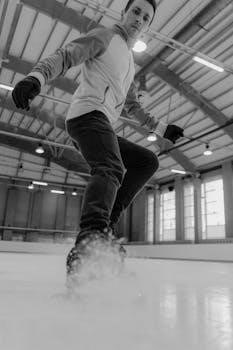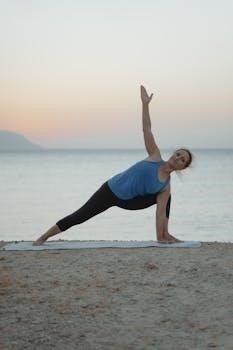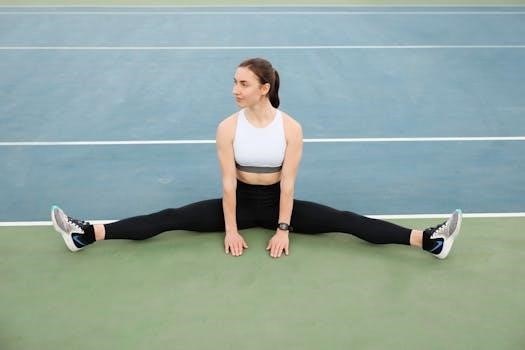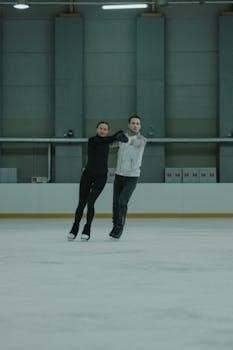Understanding ITB Syndrome
The iliotibial (IT) band is a thick strip of tissue running from the hip to the outside of the shinbone. Inflammation of this tissue can cause pain in the leg‚ often referred to as ITB syndrome. It commonly affects runners‚ weightlifters‚ hikers‚ and cyclists‚ disrupting free movement and limiting enjoyment of life.
What is ITB Syndrome?
ITB Syndrome‚ or iliotibial band syndrome‚ is a common condition characterized by pain along the outside of the knee‚ hip‚ or even the back. This pain arises from the inflammation or irritation of the iliotibial band‚ a thick band of connective tissue that runs along the outer thigh‚ from the hip down to the shinbone. The IT band is not a muscle but rather a strong‚ fibrous tissue that helps stabilize the knee and hip during movement. When this band becomes overly tight or inflamed‚ it can lead to friction and pain where it crosses the bony prominence of the knee. ITB syndrome is often associated with repetitive activities like running‚ cycling‚ and weightlifting‚ where repeated bending and straightening of the knee can exacerbate the issue. This condition is also frequently related to hip weakness and instability while standing on one leg. The pain from ITB syndrome can be persistent and can disrupt the ability to move freely‚ limiting the enjoyment of everyday activities.
Common Causes of ITB Tightness
Several factors can contribute to the tightness and subsequent pain associated with ITB syndrome. One of the most frequent culprits is overuse‚ particularly in activities involving repetitive knee movements such as running‚ cycling‚ and hiking. These activities can cause increased friction where the IT band passes over the outer knee‚ leading to inflammation and tightness. Another common cause is muscle imbalances‚ especially weakness in the hip abductors and gluteal muscles. When these muscles are weak‚ the IT band may overcompensate‚ leading to increased tension. Poor biomechanics‚ such as improper running form or inadequate footwear‚ can also contribute to ITB tightness. Additionally‚ insufficient stretching and flexibility‚ particularly in the muscles surrounding the hip and thigh‚ can make the IT band more prone to tightness. Finally‚ activities that involve standing on one leg without adequate stability can also contribute to the condition. Understanding these common causes is crucial for effective management and prevention of ITB syndrome.

ITB Exercises and Stretches
Managing ITB tightness involves a combination of exercises and stretches. While direct IT band stretching may not be effective‚ focusing on surrounding muscles like the TFL and glutes‚ along with strengthening exercises‚ is crucial for relief and prevention.
Why ITB Stretching is Not Always Effective
The iliotibial band‚ or IT band‚ is not a muscle but rather a thick band of connective tissue. This makes it inherently difficult to stretch effectively. Unlike muscles‚ connective tissue has limited elasticity and is designed to provide stability rather than flexibility. Therefore‚ attempting to directly stretch the IT band often proves futile and can even exacerbate the problem by causing irritation or inflammation in the surrounding tissues. The primary issue is usually not the IT band itself‚ but the tightness and imbalance in the muscles that attach to it‚ such as the tensor fasciae latae (TFL) and the gluteal muscles. Focusing on these muscles through targeted stretches and strengthening exercises is a more effective approach to address ITB issues. Direct IT band stretches often fail to relieve the underlying causes of tightness‚ which lie in muscle imbalance and weakness‚ leading to the persistence of symptoms.

Effective Stretches for Surrounding Muscles (TFL and Glutes)
Instead of trying to stretch the IT band directly‚ focus on the muscles that attach to it‚ primarily the tensor fasciae latae (TFL) and the gluteal muscles. To stretch the TFL‚ try a standing side stretch‚ crossing the leg you wish to stretch behind the other‚ and gently leaning to the opposite side‚ feeling the stretch along the outer hip. For the glutes‚ the figure-four stretch is effective; lie on your back‚ place one ankle on the opposite knee‚ and gently pull the thigh of the bottom leg toward your chest. Another great way to target the glutes is through a seated twist stretch‚ or the lying hip external rotation stretch. Holding these stretches for 30 seconds‚ repeating three times on each side‚ will gradually increase flexibility and reduce the tension that contributes to IT band issues. Remember‚ a gentle stretch is the key; discontinue if any pain worsens.
Recommended Strengthening Exercises
Strengthening the muscles around the IT band is as important as stretching them. Focus on exercises that target the core‚ glutes‚ and hip abductors. These include side-lying leg raises‚ which engage your core and hip muscles‚ and clamshell exercises which activate the gluteus medius. Side lying hip abduction is also effective in strengthening the hip abductors. The figure-four bridge not only stretches the glutes but also strengthens them‚ providing added support. Another great exercise is the glute wall press isometric hold‚ which builds strength and stability in the gluteal muscles. Start each exercise slowly‚ and increase repetitions as you get stronger. Proper form is essential to avoid injury. Remember to listen to your body‚ and ease off if you experience any pain during these exercises. Consistency is key to seeing results and preventing future issues;
Side-Lying Leg Raises
Side-lying leg raises are a foundational exercise in strengthening the muscles that support the IT band. To perform this exercise‚ lie on your side with your legs stacked and straight. Keep your bottom leg slightly bent for stability. Slowly raise your top leg toward the ceiling‚ keeping it straight and controlled. Avoid any sudden movements or jerky motions; the movement should be slow and deliberate. Lower your leg back down with control‚ resisting gravity. Focus on engaging your core and hip abductors throughout the exercise. This will ensure that the correct muscles are being targeted. Perform this exercise on both sides. Start with a lower number of repetitions‚ such as 10-12‚ and gradually increase as your strength improves. This exercise is crucial for strengthening the hip abductors‚ which help to stabilize the pelvis and reduce strain on the IT band.
Clamshell Exercises
Clamshell exercises are a gentle yet effective way to activate and strengthen the gluteus medius‚ a key muscle in hip stability‚ which is often weak in individuals with ITB issues. Begin by lying on your side with your knees bent and stacked‚ and your feet aligned with your buttocks. Keep your heels touching throughout the exercise. Keeping your hips stacked and stable‚ slowly lift your top knee while keeping your feet together‚ resembling a clamshell opening. Avoid rolling back or forward; the movement should only occur at your hip joint. Pause briefly at the top and then slowly lower your knee back to the starting position. It is vital to engage your core and avoid using momentum. Perform this exercise on both sides. Start with a set of 10-15 repetitions and gradually increase as your strength improves. Clamshells help to build the strength and endurance of the hip abductors‚ reducing the strain on the IT band.
Side Lying Hip Abduction
Side-lying hip abduction is another excellent exercise for strengthening the hip abductors‚ which are important for stabilizing the pelvis and preventing ITB issues. To perform this exercise‚ lie on your side with your legs extended and stacked on top of each other. Engage your core to stabilize your spine. Slowly lift your top leg towards the ceiling‚ keeping it straight and in line with your body. Avoid rotating your leg or torso. Focus on the movement coming from your hip joint. Pause briefly at the top of the movement‚ and then slowly lower your leg back to the starting position. Make sure to keep the movement controlled and avoid any jerky motions. Repeat on both sides. Begin with 10-15 repetitions‚ and gradually increase the number of repetitions as you gain strength. This exercise helps to strengthen the muscles that control hip stability and prevent excessive strain on the IT band‚ thus reducing knee and hip pain.
Figure-4 Bridge
The Figure-4 Bridge is a great exercise that targets the glutes and hip muscles while also incorporating a gentle stretch. To begin‚ lie on your back with your knees bent and your feet flat on the floor. Place your right ankle on your left knee‚ creating a figure-4 shape with your legs. Engage your core and press down through your left foot‚ lifting your hips off the floor. Ensure your body forms a straight line from your shoulders to your left knee. Squeeze your glutes at the top of the bridge and hold briefly before slowly lowering your hips back down. Repeat the exercise on the opposite side‚ placing the left ankle on the right knee. Focus on maintaining stability throughout the exercise and avoid arching your back. This exercise not only strengthens the glutes but also stretches the hip rotators and can provide relief to the IT band by addressing imbalances in the surrounding muscles.

Glute Wall Press Isometric
The Glute Wall Press Isometric exercise is an effective way to activate and strengthen the gluteal muscles‚ crucial for ITB syndrome management. To perform this exercise‚ stand with your back against a wall‚ feet shoulder-width apart‚ and slightly forward from the wall. Gently bend your knees to a comfortable angle‚ ensuring your knees don’t go past your toes. Press your back firmly into the wall and consciously engage your glute muscles. Focus on squeezing your glutes as if you are trying to push your hips and pelvis into the wall. Hold this contraction‚ maintaining the pressure against the wall for a specified duration‚ typically 20 to 30 seconds. It’s essential to maintain good posture‚ avoiding any arching in your lower back. This isometric exercise increases gluteal strength and stability around the hips‚ helping to alleviate pressure and strain on the IT band. Regular practice can improve overall hip mechanics.

Additional Treatments and Considerations
Beyond exercises and stretches‚ foam rolling can aid in releasing tension around the IT band. Physical therapy can provide personalized treatments‚ incorporating manual techniques‚ and modalities to improve alignment‚ reduce pain and promote long-term healing for ITB syndrome.
Foam Rolling Techniques
Foam rolling is a popular technique for addressing IT band tightness‚ although it’s essential to understand its limitations. While you can’t directly stretch the IT band itself‚ foam rolling can help release tension in the surrounding muscles like the TFL and glutes‚ which attach to the IT band and contribute to its tightness. To perform foam rolling‚ position the foam roller on the outer thigh and gently roll from the hip towards the knee‚ focusing on tender spots. Apply moderate pressure‚ and avoid rolling directly over bony areas. It’s crucial to maintain control and avoid excessive pressure that could cause pain or discomfort. Foam rolling should be done with slow‚ controlled movements‚ spending 30-60 seconds on each area. While some may experience temporary relief‚ foam rolling should be incorporated as part of a broader treatment plan. This includes stretching of the surrounding muscles and strengthening exercises.
Physical Therapy for ITBS
Physical therapy is a highly effective approach for managing and treating iliotibial band syndrome (ITBS). A physical therapist will conduct a thorough assessment to evaluate your range of motion‚ strength‚ and biomechanics. Based on this‚ they’ll create a personalized treatment plan that often includes a combination of exercises‚ stretches‚ and manual therapy techniques. The focus isn’t solely on stretching the IT band directly‚ but rather on addressing the underlying muscle imbalances and weaknesses that contribute to ITBS. Therapists may use manual therapy to release tension in the soft tissues surrounding the hip and thigh and provide guided exercises. They will also teach you proper form for activities like running‚ walking‚ or cycling to avoid future issues. If you are experiencing ITBS‚ seeing a physical therapist can provide targeted support. They’ll help you regain pain-free movement and ensure a long term recovery.